The horrific carnage caused by a terrorist on Halloween, killing eight cyclists and injuring 12, was preceded by a similar, though unintentional, bike fatality in 2006 on the same bikeway.
The Hudson River Bikeway is exclusive for people. Other than service vehicles, motor vehicles are prohibited from entering the greenway, but there has been a pattern of vehicles illegally accessing the country's most popular bikeway at the intersections with cross traffic, and the results have proved fatal even prior to the Oct. 31 terrorism.
"More than 10 years ago, Eric Ng was struck and killed by a drunken motorist who drove for more than a mile on the bike path of the Hudson River Greenway," reports Sharon Otterman for The New York Times on Nov. 1. "He was killed at about the same location where the driver in a terror attack entered the bike path on Tuesday.
The bike and pedestrian advocacy group, Transportation Alternatives, has been outspoken on the need to protect bikeways from these types of incidents, where motorists, whether inadvertently or intentionally, drive on popular, exclusive paths for cyclists and pedestrians.
"Prompted by Eric’s death, advocates have fought for more than a decade to block vehicular access to the Greenway with a common measure known as bollards," states deputy director Caroline Samponaro. "These life-saving bollards are already in place at some intersections along the Greenway, such as at Murray and Vesey Streets, but are far from standard and for no good reason."
Samponaro also clarifies the title of this post: "While terrorism is not preventable, the ability for a driver to drive [on the bikeway] was," she told Otterman.
"Another bike-path fatality in 2006, of Dr. Carl H. Nacht, a 56-year-old physician, near West 38th Street, helped fuel a call by transportation advocates to make the path,,,,more secure," adds Otterman.
Transportation Alternatives called for several reforms, including closing as many vehicle access points as possible and installing retractable bollards at crossings that have to remain open. The bollards could sink into the ground if emergency or park vehicles needed access.
Foreseeable
"The weaponization of motor vehicles is increasingly common, as we saw earlier this year in Barcelona, Charlottesville and Times Square," adds Samponaro in TransAlt's Nov. 1 press release. "But the truth is -- before the rise of weaponization of motor vehicles -- traffic crashes all too often taken pedestrian and cyclist lives in New York City."
Inappropriately placed barriers
"[I]n an effort to protect the popular path from future terror attacks, New York transportation authorities on Thursday began placing hundreds of large concrete barriers at 57 intersections along the Hudson River Park Bikeway, reports Otterman on Nov. 2.
At each of the 31 vehicle access intersections, the State Department of Transportation will put in six concrete jersey barriers. At each of the 26 pedestrian access intersections, the City Department of Transportation will place two large concrete cubes.
“After these safety measures are installed, there may be areas at the intersections that will be more narrow than they used to be,” said Ben Sarle, a spokesman for Mayor Bill de Blasio, adding that the placement of the barriers may be changed if they are found to cause congestion. “But, I would trade a little speed for substantially more safety any day.”
However, some of the barriers are installed in the pathway itself, as the Streetsblog NYC photos illustrate, causing more than just congestion.
"The 20 foot linear jersey barriers installed across the greenway by the Governor’s State DOT are particularly dangerous, as they are channeling two-way bike traffic into one lane, effectively putting north and southbound cyclists on a collision course," stated Paul Steely White, Executive Director of Transportation Alternatives, in a Nov. 3 press release.
"[W]hen the city fills bike lanes with enormous concrete barriers, further limiting what precious little dedicated bike space is available in the city, they aren't just making commutes for thousands of New Yorkers slower and more dangerous -- they're actively reinforcing the false idea that New Yorkers should be scared to bike right now."
FULL STORY: Manhattan Terror Attack Exposes Bike Path’s Vulnerable Crossings

Alabama: Trump Terminates Settlements for Black Communities Harmed By Raw Sewage
Trump deemed the landmark civil rights agreement “illegal DEI and environmental justice policy.”

Planetizen Federal Action Tracker
A weekly monitor of how Trump’s orders and actions are impacting planners and planning in America.

The 120 Year Old Tiny Home Villages That Sheltered San Francisco’s Earthquake Refugees
More than a century ago, San Francisco mobilized to house thousands of residents displaced by the 1906 earthquake. Could their strategy offer a model for the present?

Opinion: California’s SB 79 Would Improve Housing Affordability and Transit Access
A proposed bill would legalize transit-oriented development statewide.

Record Temperatures Prompt Push for Environmental Justice Bills
Nevada legislators are proposing laws that would mandate heat mitigation measures to protect residents from the impacts of extreme heat.

Downtown Pittsburgh Set to Gain 1,300 New Housing Units
Pittsburgh’s office buildings, many of which date back to the early 20th century, are prime candidates for conversion to housing.
Urban Design for Planners 1: Software Tools
This six-course series explores essential urban design concepts using open source software and equips planners with the tools they need to participate fully in the urban design process.
Planning for Universal Design
Learn the tools for implementing Universal Design in planning regulations.
Clanton & Associates, Inc.
Jessamine County Fiscal Court
Institute for Housing and Urban Development Studies (IHS)
City of Grandview
Harvard GSD Executive Education
Toledo-Lucas County Plan Commissions
Salt Lake City
NYU Wagner Graduate School of Public Service




























